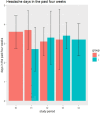Effects of neck-exercise and health promotion on headache outcomes in office workers: secondary analysis of the NEXpro stepped wedge cluster randomised controlled trial
- PMID: 39939850
- PMCID: PMC11817237
- DOI: 10.1186/s10194-025-01963-y
Effects of neck-exercise and health promotion on headache outcomes in office workers: secondary analysis of the NEXpro stepped wedge cluster randomised controlled trial
Abstract
Background: Headache conditions have a high prevalence worldwide. Office workers with high and demanding workload, but low physical activity levels are considered vulnerable for suffering from headache. This analysis examines whether exercise combined with health promotion at the workplace is effective for headache relief in office workers.
Methods: This study reports the results of secondary outcomes of a stepped wedge cluster randomized controlled trial. Office workers (n = 120) were randomly assigned to a twelve-week supervised intervention period, consisting of neck and shoulder girdle exercises with health promotion interventions performed at the workplace. Secondary outcomes were analysed and modelled for headache occurrence, frequency, and the Headache Impact Test-6 (HIT-6), accounting for possible effects for the intervention, the period it had been introduced, and interactional and nested effects.
Results: At baseline, 88 of the 120 participants reported ≥ one headache episode in the past four weeks, with a mean headache frequency of 3.58 days for that period. The mean HIT-6 score for the entire cohort amounted to 53.6 points. For headache occurrence and HIT-6, the simplest model with the intervention only, showed the best statistical fit with an odds ratio for headache occurrence of 0.46 (95% confidence interval: 0.25 to 0.84), and - 2.23 (95% confidence interval: -3.35 to -1.12) points on the HIT-6 questionnaire. For headache frequency, the model accounting for interaction effects (intervention x period) had the best statistical fit and showed an incidence rate ratio of 0.57 (95% confidence interval: 0.44 to 0.74) for the first period, but not for later ones.
Conclusions: Neck exercises and health promotion had a positive impact on headache occurrence, headache frequency and HIT-6, with the latter not reaching clinical importance. Although only statistically significant for headache frequency, larger effects were found during earlier periods or shorter interventional exposure for all outcomes, necessitating refresher sessions at later periods.
Trial registration: NCT04169646.
Keywords: Cluster RCT; Headache; Neck exercise; Office work; Stepped wedge design.
© 2025. The Author(s).
Conflict of interest statement
Declarations. Ethics approval and consent to participate: The study was approved by the Ethical Committee of the Canton Zurich, Switzerland (Ref-No: 2019-01678), and was additionally registered at clinicaltrials.gov (NCT04169646). All participants gave written informed consent at the beginning of the study. Consent for publication: Not applicable. Competing interests: The authors declare no competing interests.
Figures




References
-
- Deuschl G, Beghi E, Fazekas F, Varga T, Christoforidi KA, Sipido E, Bassetti CL, Vos T, Feigin VL (2020) The burden of neurological diseases in Europe: an analysis for the global burden of Disease Study 2017. Lancet Public Health 5:e551–e567 - PubMed
-
- Al-Khazali HM, Younis S, Al-Sayegh Z, Ashina S, Ashina M, Schytz HW (2022) Prevalence of neck pain in migraine: a systematic review and meta-analysis. Cephalalgia Int J Headache 42:663–673 - PubMed
-
- Ashina S, Bendtsen L, Lyngberg AC, Lipton RB, Hajiyeva N, Jensen R (2015) Prevalence of neck pain in migraine and tension-type headache: a population study. Cephalalgia 35:211–219 - PubMed
-
- Bogduk N, Govind J (2009) Cervicogenic headache: an assessment of the evidence on clinical diagnosis, invasive tests, and treatment. Lancet Neurol 8:959–968 - PubMed
Publication types
MeSH terms
Associated data
Grants and funding
LinkOut - more resources
Full Text Sources
Medical
Miscellaneous

